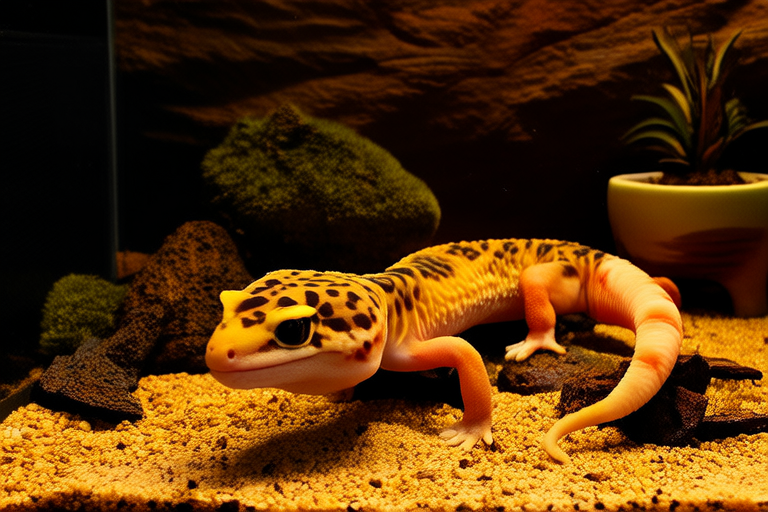How to Create the Perfect Habitat for Your Lizard Bestie
Welcome to the wonderful world of lizard ownership! Creating the perfect habitat for your scaly friend is crucial for their health and happiness. This guide will walk you through everything you need to know to set up a thriving environment for your lizard bestie.
Selecting the Right Tank Size Based on Lizard Species
The first step in creating a perfect habitat is choosing the right tank size. Different lizard species have different space requirements. For example, bearded dragons thrive in larger enclosures, while geckos can live comfortably in smaller tanks. Research your lizard’s specific needs before making a purchase. A general rule of thumb is that the tank should be at least twice as long as the lizard’s body length.
Essential Heating and Lighting Requirements
Mimicking your lizard’s natural environment is key to their well-being. Heating and lighting are critical components of this setup. Most lizards require a temperature gradient within their enclosure to regulate their body temperature. This means one end of the tank should be warmer than the other, allowing your lizard to thermoregulate.
For heating, consider a heat lamp or ceramic heat emitter. Place it on one side of the tank so that the basking spot reaches the desired temperature, typically between 95°F and 110°F (35°C and 43°C) depending on the species. Always use a reliable thermometer to monitor these temperatures.
Lighting is equally important. Full-spectrum UVB lighting is essential for most diurnal lizards, as it helps them synthesize vitamin D3, which aids in calcium absorption. Ensure the UVB light covers the entire tank, especially the basking area. Replace the bulb every six months to ensure optimal effectiveness.
Appropriate Substrate Options
The substrate, or flooring material, in your lizard’s habitat plays a significant role in their comfort and health. It should be safe, easy to clean, and suit your lizard’s natural behaviors. Common substrate options include:
- Cedar and pine shavings: Not recommended due to potential respiratory issues.
- Reptile carpet: Easy to clean and safe for most lizards.
- Newspaper: Affordable and simple to replace but less aesthetically pleasing.
- Coconut fiber: Retains moisture well and is suitable for humid environments.
- Calcium sand: Ideal for desert species like bearded dragons but avoid if your lizard tends to ingest it.
Choose a substrate that matches your lizard’s natural habitat and behavior.
Necessary Hides and Decorations
Hiding spots and decorations are essential for providing enrichment and security. Lizards need places to hide to feel safe and secure. These can be caves, hollow logs, or artificial plants. Ensure any decoration is sturdy and cannot tip over, causing injury.
In addition to hides, add branches and rocks for climbing and basking. Arrange these structures to create various levels within the tank, simulating their natural environment. This encourages physical activity and mental stimulation.
Humidity Levels
Humidity is another vital aspect of your lizard’s habitat. Different species have varying humidity needs. Tropical species like green anoles and crested geckos prefer higher humidity levels, usually between 60% and 80%. Desert species, such as leopard geckos and bearded dragons, require lower humidity, around 30% to 40%.
To maintain the correct humidity level, use a hygrometer to monitor it. If the humidity is too low, mist the tank or place a water dish. For higher humidity, consider using a fogger or adding more live plants.
Feeding Stations
Your lizard’s diet is as important as their environment. Setting up a proper feeding station ensures they get the nutrients they need. Feeders, such as insects, should be dusted with calcium and multivitamin powders before being offered. Place food dishes in a secure location away from heat sources to prevent spoilage.
Some lizards, particularly herbivorous species, also require fresh vegetables and fruits. Offer these in a separate dish to avoid contamination. Remove uneaten food promptly to maintain hygiene.
Regular Cleaning Schedules
A clean habitat is crucial for your lizard’s health. Regular cleaning prevents the buildup of bacteria and parasites. Establish a cleaning schedule based on your lizard’s needs and the type of substrate used.
Weekly tasks include:
- Removing waste and uneaten food.
- Wiping down the tank walls and accessories.
- Changing water in dishes.
Bioactive substrates, which use live plants and beneficial microorganisms to break down waste, reduce the frequency of deep cleans. However, even with bioactive setups, deep cleaning should occur every few months to ensure optimal conditions.
Tips for Beginners
If you’re new to lizard ownership, start by thoroughly researching your chosen species. Understanding their specific care requirements will help you provide the best possible habitat. Join online communities or forums to connect with experienced owners who can offer advice and support.
Invest in quality equipment from the beginning. While cheaper alternatives may seem appealing, they often lack durability and functionality. Proper heating and lighting are especially important for your lizard’s health.
Advice on Common Mistakes to Avoid
One common mistake is keeping multiple lizards together. Many lizard species are solitary and may become stressed or aggressive when housed with others. Always research whether your lizard can coexist peacefully with others.
Another frequent error is neglecting regular maintenance. Even if your lizard seems healthy, a dirty tank can lead to infections and other health issues. Stay vigilant about cleaning and monitoring your lizard’s condition.
Finally, avoid placing the tank near windows or drafty areas. Direct sunlight can cause overheating, while drafts can lead to temperature fluctuations. Choose a stable location for your lizard’s habitat.
Conclusion
Creating the perfect habitat for your lizard bestie involves careful consideration of their specific needs. By providing the right tank size, heating and lighting, substrate, hides, decorations, humidity, feeding stations, and maintaining a regular cleaning schedule, you’ll ensure your lizard thrives. Remember, mimicking their natural environment is key to their health and happiness. With these guidelines, you’ll be well on your way to becoming a responsible and loving lizard owner.
